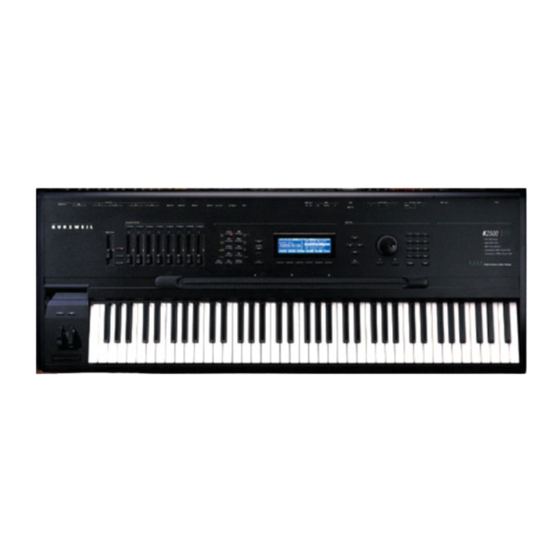
Table of Contents
Advertisement
Quick Links
Chapter 4
The Operating Modes
In this chapter we'll discuss the theory behind the mode system, and describe the basic
operating features of each mode.
What the Modes Are
The modes exist to make the K2500 logical to work with. With as many performance and
programming features as the K2500 has, it's helpful to break them into groups. These groups
are called modes. There are eight of them; they're described briefly in the section called "Using
the Modes," below. Chapters 6 through 13 are dedicated to explaining each mode in turn.
Each mode is named for the kind of operations you perform while in that mode, and each
mode's editor (if any) contains all of the parameters related to editing the type of object found
in that mode. In Setup mode, for example, you select setups (and only setups) for performance
or editing. All of the setup-editing parameters are grouped together on the Setup Editor page,
which is accessible through Setup mode.
Selecting Modes
When the K2500 is on, it's always operating in one of the eight modes represented by the LED-
highlighted buttons beneath the display. Pressing one of the mode buttons selects that mode.
This is the mode's entry level. At the entry level, the LED of the selected mode is lit. Only one
mode can be selected at a time.
At the entry level, you can exit any mode simply by pressing one of the other mode buttons. If
you enter the mode's editor, however, you must press EXIT to return to the mode's entry level
before selecting another mode.
All of the modes except Disk mode give you access to one or more editors for changing the
values of the parameters within that mode. Press the EDIT button to enter the editor of the
currently selected mode. When you do this, the mode LED goes out.
It's possible to enter another mode's editor without leaving the currently selected mode. For
example, if you press EDIT while in Setup mode, you'll enter the Setup Editor. The Setup editor
page will appear, and one of the programs in the setup will be highlighted by the cursor. If you
press EDIT again, you'll enter the Program Editor, where you can edit the currently selected
program. While you can edit and save programs as you normally would, you're still in Setup
mode, and you can't select another mode at this point. When you exit the Program Editor,
you'll return to the Setup Editor page. Press EXIT again, and you'll leave the Setup Editor,
returning to the Setup mode page.
The Operating Modes
Selecting Modes
4-1
Advertisement
Table of Contents

Summary of Contents for Kurzweil K2500 - PERFORMANCE GUIDE REV F PART NUMBER 910251 CHAP 4
- Page 1 The Operating Modes Selecting Modes Chapter 4 The Operating Modes In this chapter we’ll discuss the theory behind the mode system, and describe the basic operating features of each mode. What the Modes Are The modes exist to make the K2500 logical to work with. With as many performance and programming features as the K2500 has, it’s helpful to break them into groups.
- Page 2 The Operating Modes Selecting Modes PROGRAM MODE QUICK SETUP EFFECTS MIDI MASTER SONG DISK ACCESS MODE MODE MODE MODE MODE MODE MODE QUICK SETUP EFFECTS SONG ACCESS EDITOR EDITOR EDITOR EDITOR PROGRAM EDITOR VELOC. PRESS. INT. TABLE EDITOR EDITOR EDITOR KEYMAP EDITOR SAMPLE...
- Page 3 The Operating Modes Using the Modes Finding Square One If, at any time, you don’t know where you are, and the mode LEDs are all unlit, press EXIT one or more times. This will return you to the entry level of whatever mode you were in, and if you press EXIT enough times, you will always return to Program Mode, the startup mode.
- Page 4 The Operating Modes Using the Modes for each program individually.) The Effects Editor allows you to tweak the preset effects, and create your own. Chapter 9 shows you how. You can also listen to the sounds of various effects while in Effects mode, without selecting different programs. MIDI Mode You’ll use MIDI mode to configure the K2500’s interaction with other MIDI instruments, by setting parameters for transmitting and receiving MIDI.
















Need help?
Do you have a question about the K2500 - PERFORMANCE GUIDE REV F PART NUMBER 910251 CHAP 4 and is the answer not in the manual?
Questions and answers